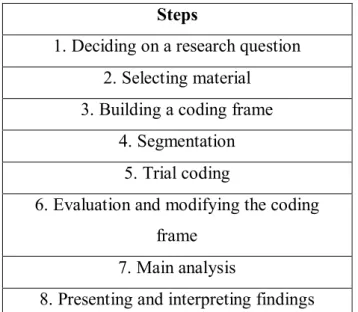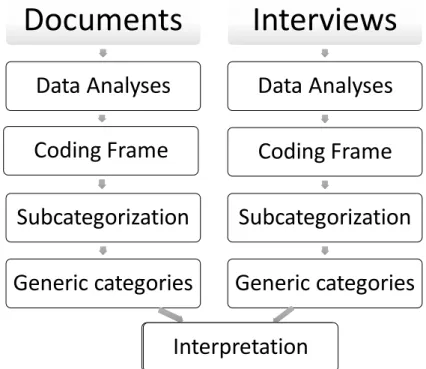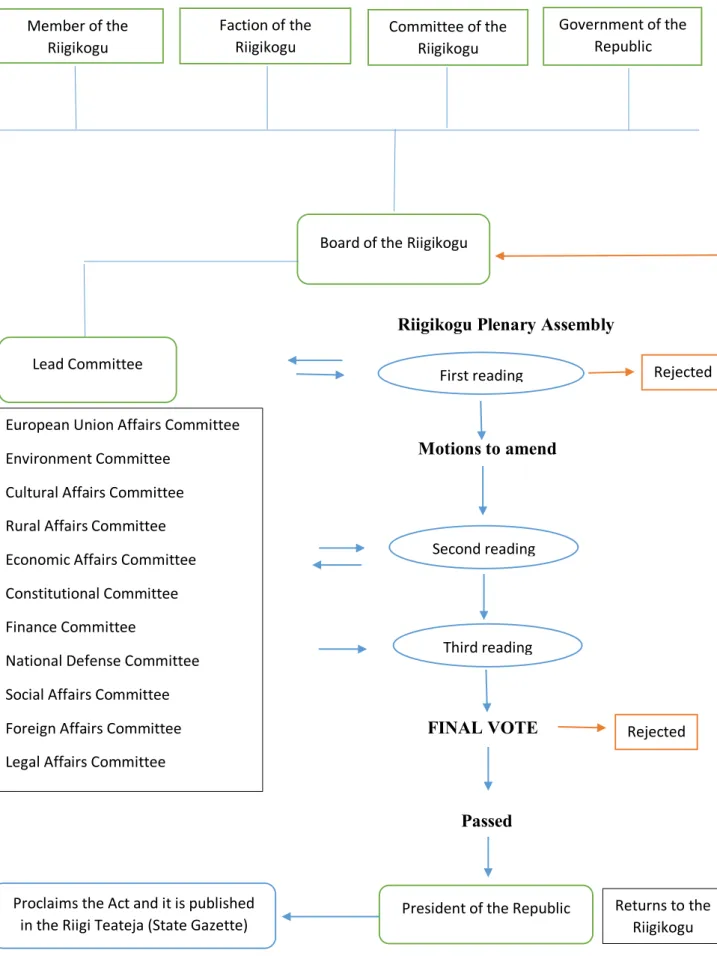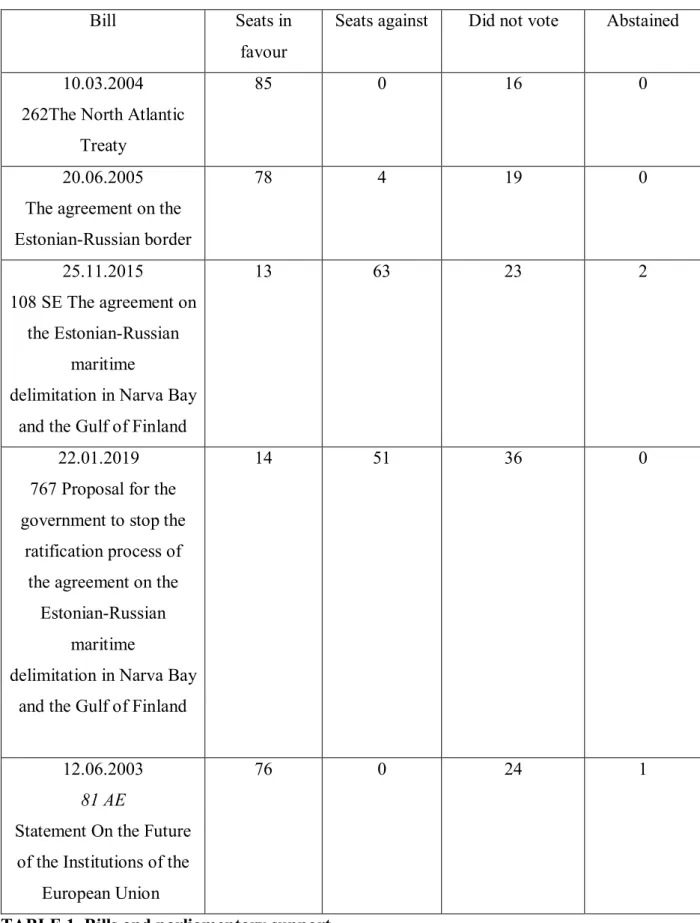EVOLUTION OF THE PERCEPTION OF ESTONIAN POLITICAL ELITE ON FOREIGN POLICY OF THE REPUBLIC OF ESTONIA, 1999-2019. According to the analysis of the election programs and party manifestos, policy consensus exists in Estonian foreign policy.
INTRODUCTION
- Background
- Theoretical Framework and Literature Review
- Research Questions, Methods and Materials
- Structure of the Thesis
Furthermore, I will identify differences (if any) on foreign policy issues among political parties represented in the Riigikogu. My hypothesis is the following: There has been a domestic consensus among political parties represented in the Riigikogu on Estonian foreign policy since 1999.
THEORETICAL FRAMEWORK
Relationship between Foreign Policy and Domestic Policy
- Relationship between foreign policy and domestic policy in Liberalism
Ideational liberalism considers public groups and their preferences as one of the key factors influencing the foreign policy of the state. As mentioned above, foreign policy is a derivative of relations between internal social groups (political parties).
Definition of the Concept: Foreign Policy Consensus and Its Basic Elements
Taking the case of Estonia, we can assume that this element of consensus can be represented in the country's foreign policy vector, but there are some fears that it may fall apart. To confirm or deny this assumption, the analytical chapter of the master's thesis will examine the development of Estonian foreign policy from 1999 to 2019.
Linkage between Foreign Policy Consensus and Position of the State
Based on what has been said above, one can consider that consensus on foreign policy is one of the most important factors of stability and success of both domestic and foreign policy. It can therefore be assumed that it is more likely that Estonia will be successful in its domestic and foreign policy when compared to the situation of no consensus.
METHODOLOGY
Content Analysis
The method of content analysis is one of the most common scientific tools for the applied study of textual information. The method was introduced into scientific circulation at the end of the 1930s in the USA. It is done by classifying the material as instances of the categories of the coding framework” (Schreier, 2012:1).
The main idea of the approach is to derive knowledge from a theory or logic (Ibid: 85). The choice of strategy is explained by the fact that this strategy does not limit the search and allows me to mix concept-driven and data-driven strategies for the main categories and subcategories. Next, I will apply deductive coding to identify whether there is consensus, comparing the findings with the theoretical model presented in the theoretical framework of the current research.
As for the expert interviews, I will create a questionnaire that will help me answer the research questions of the dissertation, and the relevant answers of the interviewees will be presented in the study.

Sources of Data Collection
- Interviews
- Party manifestos, other documents and media materials
- Analysis of the data
I was very pleased that all the interviewees emphasized that the topic of the research is current and very interesting to study. The fourth interlocutor is Vladislav Vorotnikov, a Russian researcher who specialized in the foreign policy of the Baltic states and their political systems. I assume that everyone knows the political parties in Estonia well and can give reliable information about the development of the perception of Estonian foreign policy.
Despite the fact that the number of interviews is limited, I think that combining them with data obtained from party manifestos and election programs will provide enough data to answer the research questions of the thesis. In order to answer the research questions of the dissertation, much attention must be paid to the election programs of political parties, which were presented for the parliamentary elections in the Riigikogu. In addition, I will study transcripts of the proceedings in the Riigikogu referring to the discussions on the vote for the bills (treaty on NATO accession, treaty on the Estonian-Russian border and Declaration on the future of the institutions of the European Union) which I will analyze in the current research.
The entire picture of the process that will be applied in this study is illustrated in Figure 1.

BACKGROUND: ESTONIA’S POLITICAL SYSTEM AND FOREIGN POLICY
Political System in Estonia
Procedural and Internal Rules Act, supported legislative acts are submitted for proclamation to the President of the Republic, who may, if necessary, use the right of veto and return the bill to the Riigikogu. To vote in general elections, a person must be a citizen of the Republic of Estonia and have reached the age of 18 (Constitution of the Republic of Estonia, 1992: Article 57). Taking into account the research importance of the master's thesis, attention should be paid to the committee regarding foreign policy issues.
The Foreign Affairs Committee and the Riigikogu delegations are among the main actors managing the Riigikogu's foreign relations. According to the Foreign Relations Act, the powers of the Riigikogu in the field of foreign policy are as follows: The main duties of the Riigikogu can thus be summarized as follows: “1) making laws and assessing the quality and effects of bills;
Thus, the three most important tasks of the Riigikogu are the adoption of laws and regulations, the exercise of parliamentary control and the development of international relations.
Estonian Foreign Policy Line, 1999-2019
Regarding the Global Agreement on Migration, there were some discussions in the government, there was no consensus on signing the pact, so the pact was discussed by the Riigikogu, which supported the ratification of the pact with a simple majority (ERR.ee So we see that Estonia's foreign policy direction regarding further integration into international organizations and mechanisms are still on the agenda. When defining the main directions of Estonian foreign policy, it is interesting that some researchers can clearly define its directions. , while some of them consider it difficult to do so.
NATO; on a bilateral level – strategic partnership with the USA and the countries of the Baltic region); Thus, we can see that Estonia's political course during the last two decades has been practically uni-linear, almost monotonous, it seems to be widely accepted by the majority of political parties and voters (Lagerspetz & Vogt, 2013: 66). It has been argued that despite some divergences in foreign policy management methods, none of the parties represented in the Riigikogu question the basis of Estonia's strategic course (Vorotnikov.

ANALYSIS: FOREIGN POLICY CONSENSUS AND POLITICAL PARTIES
Party Electoral Programs/Manifestos
- Riigikogu X Elections, 2003
- Riigikogu XI Elections, 2007
- Riigikogu XII Elections, 2011
- Riigikogu XIII Elections, 2015
- Riigikogu XIV Elections, 2019
Pro Patria supports Estonia's foreign policy direction towards integration into the EU and NATO. According to the Coalition Party's election manifesto, they stand for the further integration process into the EU and NATO. Moreover, the Center Party supports Estonia's participation in the development of NATO and the European Union's Rapid Response Force.
Together with the previous parties, the Moderate stands for the accession to the EU and NATO. To summarize, I can conclude that all parties presented in the Riigikogu stand for the accession to the EU and NATO structures. Moreover, Social Democrats support Estonia's involvement in finding solutions to the EU-frozen conflicts (Nagorno-Karabakh, Abkhazia, South Ossetia).
According to the Center Party's election manifesto, they guarantee a contribution to the NATO budget of at least 2% of GDP per year.
Interviews
- Foreign policy decision-making in Estonia
- Fundamental issues in Estonia’s foreign policy
- Evolution of Estonian foreign policy
- National debates on foreign policy issues
Therefore, the next number refers to the question of who is the head of Estonian foreign policy. Lanko said that the leaders of Estonian foreign policy are the people who do that. Considering the responses of the interviewees, public opinion does not play a major role in the process of foreign policy making.
As for the head of Estonian foreign policy, a person who determines the country's foreign policy vector, there is no straightforward answer. The interviewees agreed that the main emphasis in Estonian foreign policy is NATO and the EU. It is interesting to note that the trend towards the similar emphasis on foreign policy issues still persists.
At the same time, there are sometimes substantive debates on foreign policy issues in the Riigikogu.
Ratification Process in the Riigikogu
- Treaty on NATO accession
- Treaty on Estonian-Russian border
- Statement On the Future of the Institutions of the European Union
The expansion of the European Union has increased security and its internal market has been open to Estonia's exports without restrictions. The issue of ratification of the treaty on the Estonian-Russian border has been on the agenda since 1991. Here we can see that the required number of deputies voted for the ratification of the treaty and it could enter into force.
On June 12, 2003, the Riigikogu discussed the Declaration on the Future of the Institutions of the European Union (81 AE), submitted by 23 members of the Riigikogu. There were 76 votes in favor of the declaration, none against, one member of the Riigikogu abstained (see Table 3). During her speech, the Minister of Foreign Affairs, Kristiina Ojuland, emphasized that the war in Iraq and security issues triggered discussions on the institutions of the European Union and defense and security policy in the Convention on the Future of Europe.
The bill "On the future of the institutions of the European Union" thus went through the Parliament in the first reading without any restrictions or changes.

Discussion
A few days ago, when the bill was ratified by parliamentarians, there were debates on the issue of foreign policy in the Riigikogu. Moreover, the coalition agreement also partly explains the lack of debates on most foreign policy initiatives. Based on the voting results, I can assume that procedural consensus is also present in Estonia's foreign policy.
The perceptions of the interviewees and the information derived from the electoral programs of the political parties are similar on the fundamental issues in Estonian foreign policy. Almost all interviewees pointed out that there are some debates on foreign policy issues, but they are not decisive. This statement is confirmed both by the interviewees and by the analyzes of the country's foreign policy since 1999.
I cannot clearly say that political parties are the only actors that determine the country's foreign policy direction.
CONCLUSIONS
I assumed that political parties are the main domestic actors that shape the course of the country's foreign policy. What are the differences in foreign policy issues between the ruling party (the current ruling party) and the opposition. Do you think there is a public debate on foreign policy issues in Estonia?
Who is a leader of Estonian foreign policy? the one who determines the government's position on foreign policy). Could you please explain which issues are, from your point of view, the most fundamental in Estonia's foreign policy? Do you think there is a public debate on foreign policy issues in Estonia?
9. What are the differences regarding foreign policy issues between the ruling party (the current ruling party) and the opposition.
Questionnaire 1
Questionnaire 2
Election results by political parties from 1999 to 2019